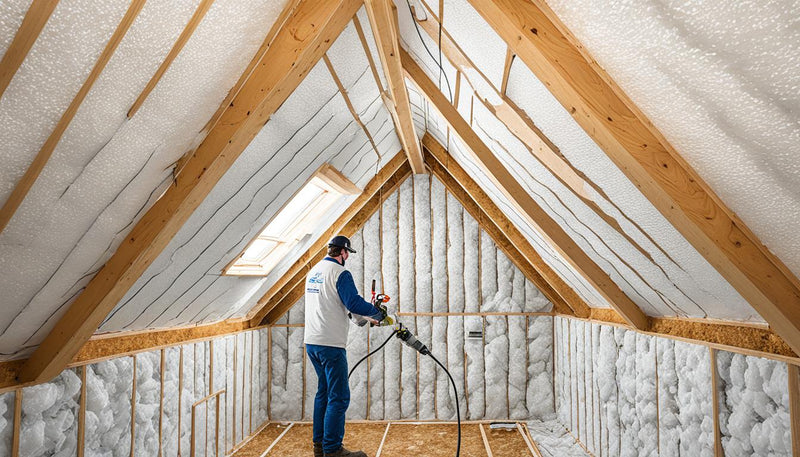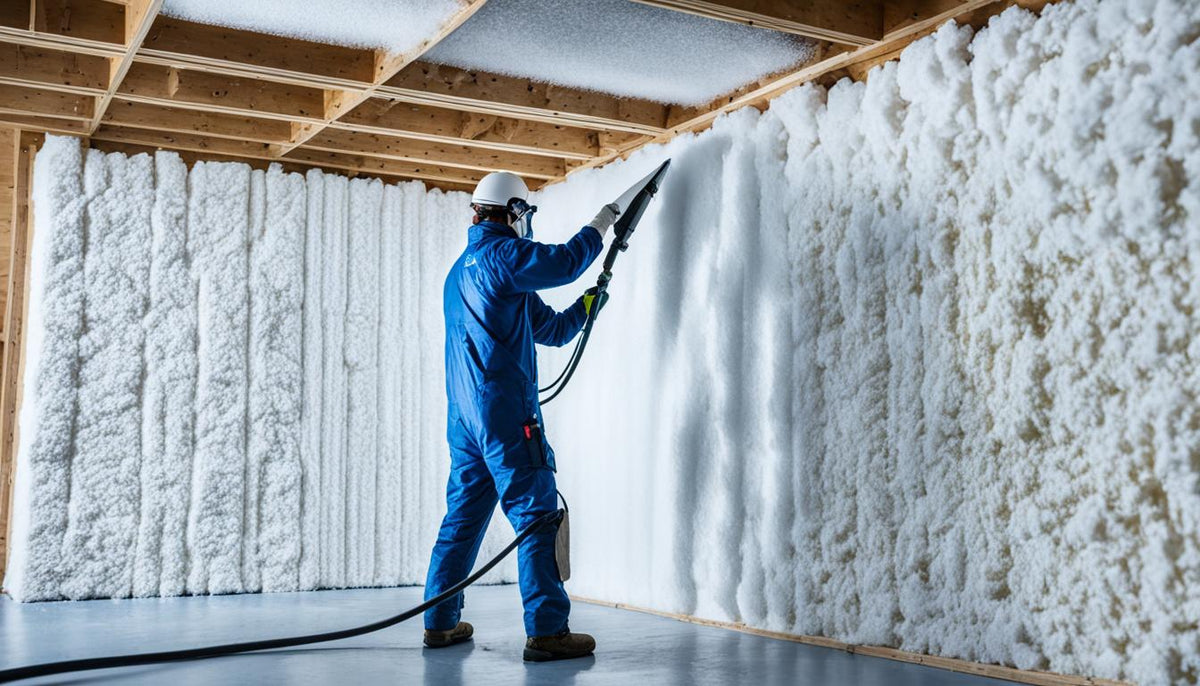Spray Foam: The Ultimate Option for Air Sealing and Insulation
Spray foam insulation has actually become a leading option for reliable air sealing and thermal insulation, providing an one-of-a-kind combination of homes that establish it apart from conventional techniques. Its capacity to increase and fill gaps makes it especially reliable in avoiding air leak, which can dramatically impact energy efficiency. Nevertheless, recognizing the complete extent of its advantages, installment procedures, and contrasts with various other insulation types is essential for making informed decisions. As we check out these elements, the ramifications for both new constructions and retrofits become increasingly significant. What factors should influence your selection?
What Is Spray Foam?
Spray foam is a flexible insulation material that incorporates the concepts of air sealing and thermal resistance to boost power effectiveness in buildings. Made up mainly of polyurethane or other comparable compounds, spray foam is used as a fluid that expands upon call with surfaces, creating a strong, continuous layer of insulation. This one-of-a-kind property enables it to fill voids, fractures, and gaps that standard insulation materials might overlook, giving an exceptional air seal.
There are two primary sorts of spray foam: open-cell and closed-cell. Open-cell spray foam is lighter and a lot more flexible, supplying outstanding audio absorption and a lower R-value per inch - Spray Foam. On the other hand, closed-cell spray foam is denser, offering a greater R-value, moisture resistance, and included structural stability to building elements
The application procedure usually entails specific tools, guaranteeing a smooth application that follows different substratums, including concrete, timber, and steel. This flexibility makes spray foam suitable for both new building and constructions and retrofitting existing structures. Its capability to develop an airtight barrier substantially adds to reducing energy usage and boosting indoor air quality, consequently making it a recommended choice among property owners and home builders alike.
Advantages of Spray Foam Insulation
Among the most significant advantages of spray foam insulation is its outstanding capacity to develop a continual air obstacle, which properly minimizes energy loss. Unlike traditional insulation materials, spray foam expands to fill cracks and gaps, guaranteeing that air leakage is dramatically minimized. This particular not only improves energy efficiency but also leads to decrease energy expenses gradually.
Furthermore, spray foam insulation offers exceptional thermal resistance, adding to an extra secure interior setting. Its high R-value per inch permits efficient insulation in confined spaces, making it ideal for attic rooms, wall surfaces, and crawl areas. Additionally, the moisture-resistant residential or commercial properties of spray foam help prevent mold and mildew and mildew growth, advertising much healthier living conditions.
An additional important benefit of spray foam insulation is its sound-dampening top qualities (Spray Foam). It successfully reduces sound transmission between areas, producing a quieter and more comfy home environment. The longevity of spray foam likewise stands out, as it does not droop or settle with time, maintaining its efficiency throughout its lifespan
Just How Spray Foam Works
Comprehending how spray foam insulation works is essential for appreciating its performance in air sealing and thermal resistance. Spray foam insulation is composed of 2 main parts: isocyanate and polyol resin. When these components are combined, they undertake a chain reaction that creates the material to increase rapidly, producing a thick foam that fills tooth cavities, voids, and cracks.
As the foam expands, it abides by surface areas, creating an impermeable seal that considerably minimizes air seepage. This particular makes spray foam insulation highly effective at stopping drafts and dampness infiltration, which can bring about energy loss and damage in time. Furthermore, the closed-cell variation of spray foam supplies premium thermal resistance as a result of its rigid structure, successfully minimizing warm transfer.
The one-of-a-kind homes of spray foam permit it to adapt irregular surface areas, making certain comprehensive protection and a seamless barrier. Consequently, spray foam insulation not just enhances energy efficiency yet additionally adds to boosted interior air high quality by minimizing the build-up of pollutants and irritants. Inevitably, comprehending the auto mechanics behind spray foam highlights its role as a superior selection for insulation and air securing in both property and industrial applications.
Setup Process Overview

Prior to installment, the space needs to be adequately cleaned up and prepped, making certain that surfaces are without moisture, particles, and dust. Due to the fact that contaminants can compromise bond and general efficiency, this action is critical. Once the area is prepared, the application involves mixing the two elements of the spray foam, which broadens upon get in touch with and loads voids click here for more info properly.
Educated professionals should conduct the installation, utilizing specialized equipment to guarantee uniform insurance coverage and optimum thickness. Safety and security preventative measures, consisting of putting on safety gear and making sure appropriate ventilation, are necessary throughout this process. After application, the foam usually remedies rapidly, forming a solid obstacle that boosts power effectiveness.
Comparing Spray Foam to Traditional Insulation
When examining insulation options, spray foam insulation stands out in contrast to conventional products such as fiberglass and cellulose. Unlike fiberglass and cellulose, which can enable air infiltration, spray foam broadens upon application, filling holes and gaps to develop a closed seal.
Additionally, spray foam supplies a higher R-value per inch than standard insulation types, using even more efficient thermal resistance in a thinner account. This characteristic is specifically useful in spaces with restricted dental caries depth. Spray foam is immune to dampness and mold development, which can be a significant worry with cellulose and fiberglass, specifically in humid atmospheres.
However, spray foam insulation normally carries a higher ahead of time cost than its conventional equivalents. Homeowners should evaluate this first financial investment against long-lasting power financial savings and efficiency benefits. Ultimately, while both insulation types serve their function, spray foam arises as an advanced service for contemporary insulation requirements, specifically in regards to air securing and thermal performance.

Conclusion
In summary, spray foam insulation represents a highly effective solution for achieving optimal air securing and thermal resistance. Its one-of-a-kind properties, including dampness resistance and audio dampening, make it ideal for numerous applications in both new buildings and retrofitting projects (Spray Foam). The preliminary costs might be higher compared to typical insulation materials, the long-lasting benefits, such as substantial energy savings and boosted indoor air quality, warrant the investment and emphasize its worth in modern structure methods.
Spray foam insulation has actually arised as a leading solution for reliable air sealing and thermal insulation, supplying a special combination of buildings that establish it apart from traditional approaches.Spray foam is a versatile insulation product that combines the concepts of air sealing and thermal resistance to boost energy effectiveness in buildings.When examining insulation options, spray foam insulation stands out in comparison to traditional materials such as fiberglass and cellulose. Inevitably, while both insulation types offer their objective, spray foam emerges as an extra advanced option for modern-day insulation requirements, specifically in terms of air sealing and thermal effectiveness.
In recap, spray foam insulation represents an extremely reliable solution for accomplishing optimum air More about the author sealing and thermal resistance.